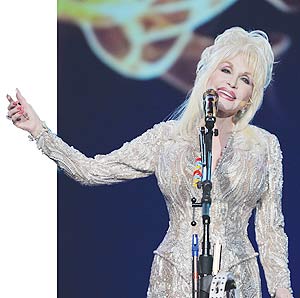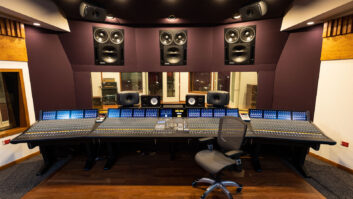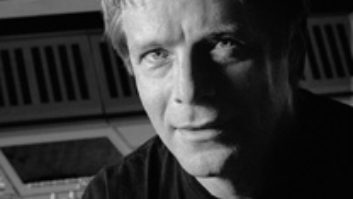
Dolly Parton performing
Photo: Steve Jennings
She is the consummate artist: a true professional with an unmistakable voice; a multi-instrumentalist and a hit-making songwriter. When a sheer piece of fabric hung from center stage was pulled away, Dolly Parton — surrounded by a top-notch eight-piece band and three background vocalists — hit the ground running, wasting no time in launching into a full two-hour set that highlighted classics (“9 to 5,” “Jolene” and “Little Sparrow”) and hits from her latest release, Backwoods Barbie. Mix caught up with the Thunder Audio-supplied tour, where we found front-of-house mixer Mike Fechner and monitor engineer Jason Glass relaxing for a few moments at Berkeley, Calif.’s Greek Theater after soundcheck.
Front-of-house engineer Mike Fechner (seated with Thunder Audio crew chief Dave Bernas) is on a maxed-out, 48-input Midas XL4 “with all the goodies. It certainly takes up a big amount of space,” he says, “but it’s just a great old classic, and with a couple of key analog pieces inserted here and there, it worked really well for us.” For outboard, he’s carrying a bunch of Distressors, Alan Smart C2s, some dbx — a lot of compressors. “There’s probably 20 in the rack,” he adds. “I use them on various things: vocals, drum fiddle, acoustic guitars.
Monitor engineer Jason Glass (seated at right, with monitor tech Dustyn Pieffer) is mixing on a Yamaha PM5 DV2 — also maxed out at 48 inputs. This tour is using a significant number of wireless mics. When asked how he’s dealing with finding a new frequency each night, he replies, “I have 29 signals to manage. We use Professional Wireless Systems to provide a combination of Shure, Sennheiser and PWS hardware. Each day, I use WinRadio to do a live scan, and I run PWS IAS software to determine what’s available on the air.”
Everyone in the band is on in-ears except Parton and the background vocalists, who have one in-ear and one wedge. Parton has 10 Meyer MJF-212A wedges arrayed in a line downstage: “It’s stereo — left, right, left, right — all the way down the stage,” explains Glass, who is also controlling two UPA-1P loudspeakers and two USW-1P subs for Parton’s band. “I have a couple of zones set up so I can control stage volume, which can be a challenge. With that many pieces, you can easily get yourself into a wall of noise. You have to rein it in, and I do a lot of panning — even as she walks across the stage, it gives her a sense of space without feeling like everything’s stacked on top of each other.” Parton hasn’t switched to in-ears because “she wants a truly open interaction with the audience. No matter how good you are at mixing in-ears, it’s still the engineer’s interpretation of reality that is presented to the artist.” Glass uses AKG C 414s to add ambience into the in-ear mixes.



